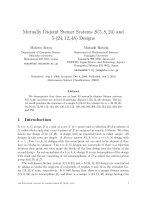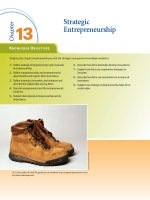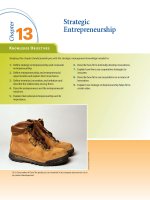Lecture Dalrymple''s sales management: Concepts and cases – Chapter 12: Compensating salespeople
Bạn đang xem bản rút gọn của tài liệu. Xem và tải ngay bản đầy đủ của tài liệu tại đây (1.23 MB, 19 trang )
Part V
SALES FORCE LEADERSHIP
Chapter 12:
Compensating Salespeople
Goals of a Sales Force
Reward System
Acceptable ratio of costs to sales force output
in volume, profit, or other objectives
Encourage activities consistent with firm’s
overall, marketing, and sales force objectives
and strategies
Attract and retain competent salespeople,
thereby enhancing longterm customer
relationships
Be clear and be flexible enough to allow
adjustments that facilitate administration
The CustomerProduct Matrix
New
Convergence
Selling
New Business
Development
Account
Management
Leverage
Selling
CUSTOMERS
Current
Current
PRODUCTS
Figure 141: The CustomerProduct Matrix
New
Compensating Salespeople
Components
SALARY
Needs
COMMISSIONS
INCENTIVE
PAYMENTS
Motivate effort on nonselling activities
Adjust for differences in territory potential
Reward experience and competence
Motivate a high level of selling effort
Encourage sales success
Direct effort toward strategic objectives
Provide additional rewards for top (Bonus) performers
Encourage sales success
SALES
CONTESTS
Stimulate additional effort targeted at specific short
term objectives
PERSONAL
BENEFITS
Satisfy salespeople’s security needs
Match competitive offers
Aligning Pay With Strategy
Government Computer Sales, Inc.’s compensation plan
ties a portion of reps' pay to the information they obtain
from their clients.
Mandates reps to dig deeper and put GCS in the minds of
the government agencies and educational institutions that
use its products.
If a rep has $15,000 of available commission for the first ½
of the year the plan would work as follows:
40% ($6,000) is tied to account management (i.e., customer
information)
60% ($9,000) is tied to a profit dollar quota
Reps who meet the documentation requirements receive all
$6,000; those who meet less than 85% do not receive the $6,000.
Use of Compensation Plans
Percentage of
Companies Using
Straight Salary
18
Straight Commission
19
Combinations Plans (63%)
Salary Plus Bonus
24
Salary Plus Commission
20
Salary Plus Bonus Plus Commission
18
Commission Plus Bonus
TOTAL
1
100%
Compensating Salespeople
Compensation Plan
Salary
Advantage
Disadvantage
No motivation
Favors unproductive
sales people
High costs when sales
are low
Compensating Salespeople
Compensation Plan
Salary
Advantage
Reduced turnover
Simple
Easy to administer
Good when difficult to
determine who made
the sale
Good when service is
required
Promotes longterm
goals
Good during drastic
business swings
Easier to transfer
salespeople
Disadvantage
No motivation
Favors unproductive
sales people
High costs when sales
are low
Compensating Salespeople
Compensation Plan
Commissions
Advantage
Motivational
Relates directly to
performance
Unlimited income
(assuming no cap)
Good for saving money
on unproductive
salespeople
Perceived fair
Disadvantage
Compensating Salespeople
Compensation Plan
Commissions
Advantage
Motivational
Relates directly to
performance
Unlimited income
(assuming no cap)
Good for saving money
on unproductive
salespeople
Perceived fair
Disadvantage
No loyalty
Little security
Short range view
High turnover
Management has
less control
Total cost per person
(thousands $)
Comparing Salary and Commission Plans
Use of Compensation Plans
50,000
Straight
Salary
40,000
30,000
20,000
10
%
is
m
m
o
C
n
o
i
s
10,000
0
100
200
300 400 500
Sales Per Person in Thousands
Advantages of Frequent vs.
Infrequent Incentive Payments
Frequent Payment Advantages
(Monthly/Quarterly)
Salespeople receive frequent
feedback and rewards when selling
cycle is short.
Rewards are close in time proximity
to the successes that provided the
reward.
Strong link between successful
behavior and reward – motivation
increased.
Infrequent Payment Advantages
(Semiannually/Annually)
Payments at bonus time are larger
and have greater impact.
Performance is more stable
because shortterm sales variations
are smoothed over the longer time
horizon.
Incentives are not paid till end of
year – smoother cash flow.
Customer Satisfaction and
Compensation
IBM places significant resources toward monitoring customer
satisfaction.
All customers are surveyed annually on:
–
–
–
–
–
–
–
–
Overall customer satisfaction
The rep’s knowledge of the customer
The transaction or solution itself
How satisfied the customer is with the solution
The installation process (smooth or disruptive), including how long it took
The extent and clarity of the education provided
The time needed to get the application(s) up and running
The capability and speed of technical support
Results are benchmarked against prior IBM performance, as well as
the competition
Results are used for compensating sales reps and managers.
Gross Margin
Commission Problem
Marketing
Plan
Selling Price
$100
Discounted
Price
$92
%
Decline
8%
Assume the following:
The salesperson makes 20% commission on the gross margin
It costs $80 to make the product.
Overhead is $10.
Gross Margin
Commission Problem
Marketing
Plan
Selling Price
Cost of Goods Sold
Gross Margin
$100
(80)
$ 20
GM% Commission
x 20%
$ Commission
$ 4.00
Contribution
16.00
Overhead Costs
(10.00)
Net Profit (Loss)
$ 6.00
Discounted
Price
%
Decline
8%
Gross Margin
Commission Problem
Marketing
Plan
Selling Price
Discounted
Price
$100.00
$ 92.00
80.00
80.00
$ 20.00
$ 12.00
x 20%
x 20%
$ 4.00
$ 2.40
16.00
9.60
Overhead Costs
10.00
10.00
Net Profit (Loss)
$ 6.00
$ (0.40)
Cost of Goods Sold
Gross Margin
GM% Commission
$ Commission
Contribution
%
Decline
8%
40%
106%
Research on Pricing and
Profits
Compensation Levels for Firms
Using Salary Plus Incentives
$161,500
$147,800
$119,600
$94,800
$71,000
Average
Sales Rep
Poorly
Performing Rep
Midlevel
Performing Rep
Base Salary
Bonus + Commission
Top Performing
Rep
Sales
Executive
Selecting Benefits
Salespeople expect cars
Insurance and travel are very common
Some plans offer a choice of alternatives









